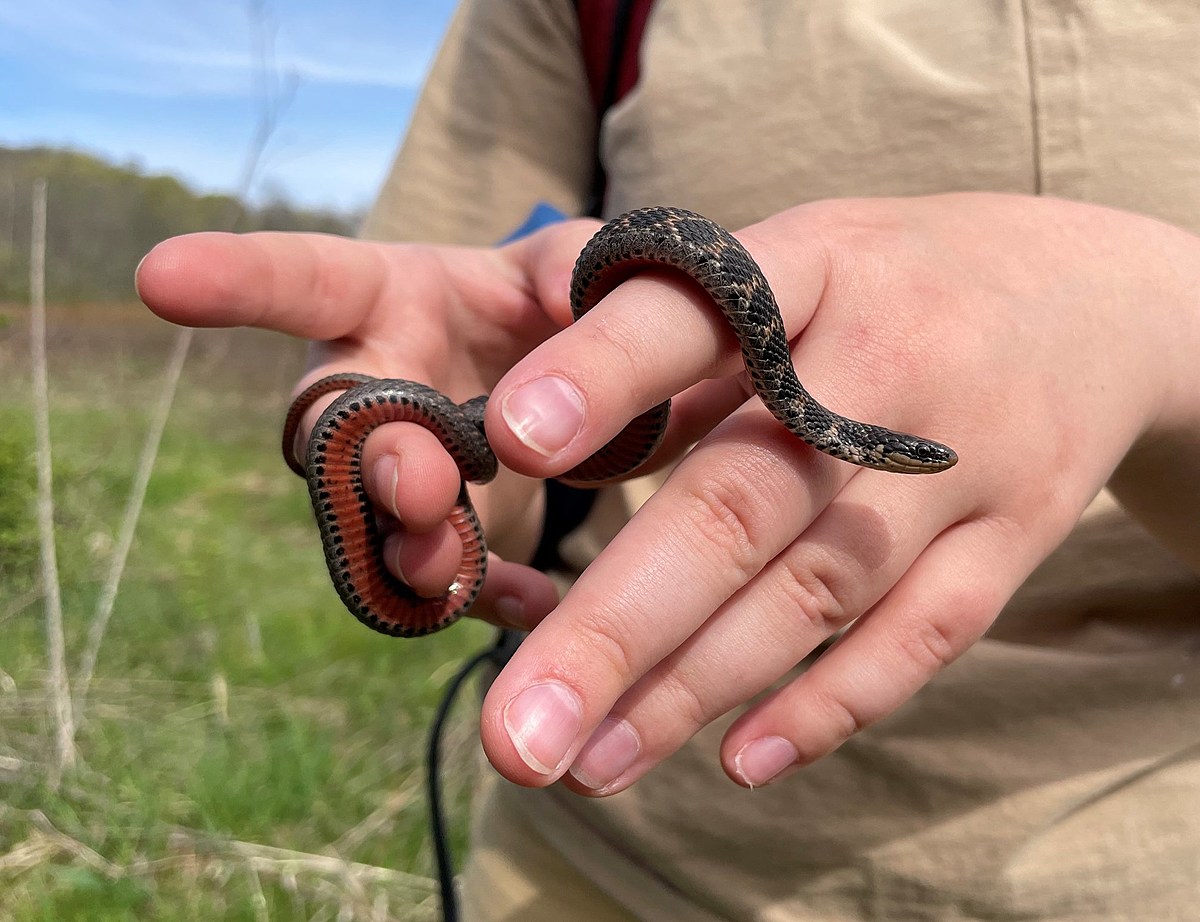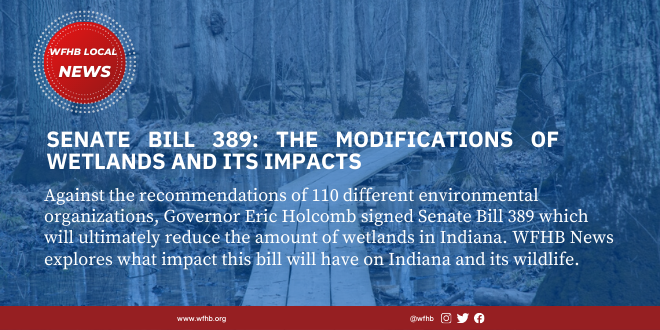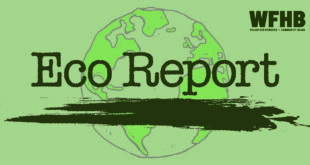Podcast: Play in new window | Download (Duration: 9:18 — 12.8MB)
Subscribe: RSS
The opposition was strong. Over 110 organizations and individuals signed and delivered a letter to the Governor’s office requesting a veto. The signers represented all parts of Indiana and multiple forms of environmental organizations. However, despite the unprecedented amount of opposition, on April 29th, Governor Eric Holcomb signed Senate Bill 389, which reduces the amount of wetlands in the state of Indiana.
Meanwhile, in a quiet part of Monroe County lies the peaceful wetlands at Beanblossom Bottoms Nature Preserve. Unaffected by the changes in the senate bill, the wetlands found here will continue to fulfill its environmental purpose for generations. However, Executive Director John Lawrence is a strong supporter of all wetlands and emphasizes the importance that wetlands have for the state of Indiana.
“Wetlands are just incredibly important reservoirs of biodiversity and they also provide really important ecosystem functions. Flood control is a big one. They act like a big sponge and soak up water and hold back water and help mitigate flooding. They also reduce pollution in waterways by collecting pollutants which can, you know, include excess nutrients. Wetlands help retain the nutrients locally so that they don’t go downstream. They are also just really important habitats for plants and wildlife. The example at Beanblossom Bottoms Nature Preserve we have recorded over a dozen species that are endangered or of conservation concern there, including the Indiana Bat, which is federally endangered, the Kirkland snake, which is a cute little snake that uses crawfish burrows and it has stayed endangered and several other things. A lot of these plants and animals rely on the wetland habitat and are not found anywhere else,” said Lawrence.

If the Beanblossom Bottoms Nature Preserve is protected then what exactly will the controversial bill the governor signed do? The bill deals with the wetlands of Indiana that are protected by state laws. Of the wetlands in Indiana, 80-90% are not protected by the federal government but have been protected at the state level. Under state protection, there are three classes of wetlands. The bill removes Class I wetlands from state protection, and also reduces the amount of Class II wetlands, while leaving Class III wetlands intact. The differences between the three classes were explained to me by Christopher Craft, a professor of rural land policy at Indiana University Bloomington.
“So again, this is back to the state of Indiana that isolated wetlands bill. They say it’s a Class 1, the lowest quality if there’s been, hydrologic alteration, like it’s been ditched or drained or filled or if it has more than 50% invasive species. So if it meets one or both of those criteria, they say it’s a class one and under the old bills, a lot of these wetlands were protected. If they are larger than a half an acre, they would be protected. You know, the Senate Bill 389 has said we’re doing away with Class1 where we’re not gonna, these are not wetlands under this bill. And if you have Class 1, isolated wetlands on your property, then you can do what you want with them. Well, let’s go to Class 3 wetlands. They’re the highest quality. They’re ones that and I think under the existing 389 bill these aren’t being affected. Um, they were protected before, and they’re protected now. They have high quality or they have high species richness, or they have rare endangered species. There aren’t that many of those you know. There’s a lot more Class 1 wetlands, and then Class 2 are kind of in the middle. They’re not, you know, severely altered or dominated by invasive species, but they’re not these super high quality sites and Senate Bill 389 affected Class 2 wetlands by saying that it used to be that I think it was more than a quarter acre in size. It would be protected. And I think under Senate Bill under 389 has said, Nah, it’s got to be bigger. It’s more than 3/8 of an acre, we’ll protect it. But if it’s less than that, it’s not going to be protected,” said Craft.
According to the National Water Summary Wetlands Resources Report, wetlands cover over 813,000 acres of Indiana and 80% of the state’s remaining wetlands fall under the categories of Class I and Class II and are now susceptible to being drained. With this information in mind and knowing the importance of wetlands, Professor Craft explained who benefits from the passing of this bill and who benefits from the change to the permits needed to remove wetlands.
“Well, I think for people who advocate growth and um, that sort of economic growth. I think that this is an argument that they would like because it’s, you know, some of this land is off the table for development or if you do want to develop it, you’re going to have to go through the permitting process. And that can be pretty lengthy and pretty rigorous. I’ve worked with, some landowners who have kind of gotten caught up in, in that, you know, that people, I think who stand to benefit, on the other hand, Indiana is not known for having, you know, the abundant natural resources, some states like Michigan have, and so when you take some of these protections away, you take away some of the limited natural resources that are still present in the state,” explained Craft.
For many farmers and land developers, the permitting process for removing wetlands is quite difficult, and the bill relaxes this process and makes it easier for Class I and some Class II wetlands to be removed. While this allows development to be easier at the moment, it does not account for the effects that the lack of wetlands could have on the future.
Opponents of the bill, including the Indiana Department of Natural Resources, have argued that the bill leaves Indiana ill-prepared to face the floods that will follow the increases in rainfall expected in future years, as well as limit essential earth processes such as water filtration, water storage, and groundwater replenishment.
Despite the passing of this bill, there is still great work being done to protect the wetlands of Indiana and restore old wetlands throughout the state. Mr. Lawrence described what effect the bill will have on the goals of the Beanblossom Nature Preserve and its organizing body, the Sycamore Land Trust.
“It certainly just means that efforts by conservation groups like Sycamore, the Nature Conservancy, our other local land trusts throughout the state to do what we can to acquire wetlands and areas that can be restored the wetlands and then put in the so large commitment of time and effort to number one, do any restoration work that’s needed and then, of course, to monitor and maintain and protect that area in perpetuity. That work just becomes all the more important when there are less efforts on the regulatory side to protect wetlands,” said Lawrence.
Lawrence says for those interested in helping conservation groups who are stepping up to the plate to protect Indiana wetlands, the Beanblossom Bottoms Nature Preserve always welcomes volunteers.
“There are a lot of ways you can support our work. The most basic is to be a donor. We have memberships starting at $40 dollars a year and it all goes into making our work possible of not only acquiring more land but also protecting and maintaining the land that is already in our care. We also have volunteer events and the best way people can get involved with that is to sign up for e-newsletter at our website at sycamorelandtrust.org,” he said.
 WFHB Bloomington Community Radio
WFHB Bloomington Community Radio


